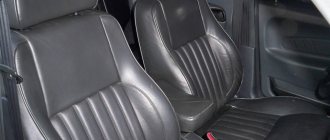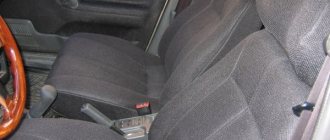Arguments from drivers who lower the seat very low
Nowadays, there are a lot of different opinions about whether low car seats are actually an advantage. Many of them seem convincing. Is this really true, or do motorists still tend to believe in myths? Here is a list of the main arguments in favor of low-slung seats.
Possibility of maintaining health
Many drivers believe that a completely upright body position puts undue stress on the spine. Due to such significant loads, inflammatory processes occurring in muscle tissue and joints quickly worsen.
Correct driving position
This happens due to the fact that the motorist’s body gradually slides down the backrest. This leads to various curvatures or pinched nerves. The result of such driving is increased driver fatigue, pain and other problems. That is why a number of motorists immediately install the seat in a reclining position.
Improper driving position
Adherents of this driving style are confident that they have a good sense of the dimensions of their own vehicle. That's why they don't have to sit upright. The number of accidents associated with improper seat adjustments indicates the opposite.
The presence of slightly lowered seat backs is just a consequence of the struggle of designers and engineers to increase the level of aerodynamics of the car. In fact, turning the steering wheel with straight arms in this position is very unsafe.
Improving driving safety
Some drivers claim that too high a seat position prevents them from seeing part of the road due to the rear view mirror blocking their view. According to such motorists, they may not notice a pedestrian who has started to cross the road, or a car at an intersection.
There are adherents of the opinion that during an accident, it is the reclining position of the seat that can protect them from hitting their chest on the steering wheel. In this case, they are partly right. But this argument only applies to older cars that do not have airbags and belt tensioners work extremely poorly.
The driver is driving in a reclining position
Any modern car does not have such problems. That is why drivers of good, safe cars have nothing to explain the desire to drive a car in a reclining position. If the backrest has the proper slope provided by the manufacturer, it should not be violated.
The car seat backrest is tilted as specified by the manufacturer.
How to properly adjust the seat position
Adjusting the driver's seat height and tilt is not a very complicated process that any motorist can handle. It should be checked every time you get into a vehicle. If you feel as comfortable as possible behind the wheel, then the risk of getting into an accident in this case will be minimal.
Seat height and tilt adjustment buttons
The adjustment process must be carried out sequentially:
The bend angle at the elbow joint can vary from 10 to 15 degrees. All of the above nuances must be checked after getting into the car.
Adviсe:
- It takes a while to get used to the correct position. If you follow the recommendations above, you will improve comfort, control and safety. You will be able to travel long distances without getting tired or suffering from pain. In addition, your control over the road will increase. In the event of an accident, your risk of injury is greatly reduced.
- Since the nineties of the last century, seat belts and seats have acquired a new level, which has increased safety and comfort during fast and long-term travel in a car.
- When holding the steering wheel, do not bend your thumbs inward, because at the moment of a collision, the front wheels may turn, and the steering wheel will also turn, as a result, your fingers may break.
- With the correct driving position, the interior space of the car increases, and your car becomes much roomier.
Steering wheel adjustment rules
The steering wheel should be adjusted to the height of the seat. This process also needs to be done immediately after boarding the vehicle. The position of the steering wheel in the car’s interior determines the driver’s ability to quickly and correctly maneuver on the road without the need to first change the position of his hands and body. Even milliseconds can save lives, especially at high speeds.
Remember right away, the steering wheel is adjustable:
You should adhere to these two important rules:
The first rule concerns the reach of the steering wheel, the second - the angle of its inclination.
Correct steering wheel adjustment does not slow down the driver's reaction speed
Under no circumstances should the driver's body be too close to the steering wheel. In such a situation, during an accident, the driver will not have the opportunity to quickly carry out the maneuver he needs.
Checking the correct fit and changing it depending on conditions
Having made the necessary seat adjustments, the driver needs to check his posture. Everything is fine if the main body weight falls on the pillow and back of the chair. How can I check this? If you can raise your arms and legs together, everything is done correctly!
Driver's driving position: right - correct, left - incorrect
Advice.
On the road, various dangerous situations happen, the reaction, like the load on the muscles, is also always different. Therefore, it is possible to deviate slightly from the standard driving position.
The settings will be different if you are driving, for example, off-road: you need to spread your elbows a little and raise them up - this way the torso muscles will be optimally tense, and it will be easier to control the car.
If you move in urban areas: you need to bend your elbows a little more
To prevent your legs from getting tired quickly, it is important to immediately lower them after pressing the pedal. This rule also applies to the hands: if you change gear, return your hand to the steering wheel
Adjusting the driver's seat: 7 steps to success
Everyone loves comfort. Apparently, this is why many motorists prefer to stretch out freely in the driver’s seat, as if on a sofa in front of the TV. But what is happening behind the windshield is not a feature film, and such a vacation can lead to very sad consequences. We will help you adjust the seat so that you are comfortable and the car is comfortable to drive.
Of course, the driver needs comfort in the car, because correct placement on the seat will avoid fatigue - the muscles will not strain too much and nothing will interfere with proper blood circulation. However, most importantly, an optimal seating position increases the driver’s readiness to react in a timely manner in the event of an emergency. Of course, the driver’s incorrect body position alone cannot cause an accident, but in unforeseen circumstances, when even fractions of seconds are important, the driver will not be able to react quickly. Like, what is one second? And this, by the way, is as much as 17 (!) meters of the distance traveled (if the asphalt is dry. Think about it, what if there is ice.) In a critical situation, this is a lot! It is for this reason that the first thing an instructor in a good driving school begins practical lessons with is an explanation of how to properly adjust the driver’s seat. After all, comfortable does not mean right. And novice drivers need to develop the right habits from the very beginning of driving. Our step-by-step instructions will help you with this.
Step 1: Position yourself correctly in the driver's seat
Before you begin adjusting your car seat, you need to get the optimal position in it. Sit up straight and press your back and buttocks firmly against the back of the seat. Then your back will be less tired, and at the same time you will have a clear view of what is happening on the road.
Step 2: Adjust the pedal distance
To begin, press the brake all the way with your right foot, and with your left foot, if you have a manual car, fully depress the clutch. If you are going to drive an automatic transmission, then rest your left foot on the place where the clutch pedal is located on cars with manual transmission. In this case, the buttocks will not budge during sudden braking, and in the event of an emergency, you will have another support in addition to the steering wheel.
Now, due to the longitudinal (back and forth) adjustment, we achieve such a position that the legs do not straighten completely even when you press the pedals all the way. Also, you shouldn't be dragging your feet toward the pedals, and you shouldn't have your knees sticking out like you're an overgrown child on a tiny tricycle.
If your knees are fully extended, move your seat closer to the steering wheel. If the opposite legs are too bent, move the seats back. By the way, the first position is also dangerous because the straight legs break during a car impact, causing injuries to the lower back and spine.
When pressing on the pedals, make sure that your heels are not in the air. The right foot should be under the brake pedal, but able to reach the accelerator pedal with the toe.
Step 3: Adjust the driver's seat backrest
When landing, as we noted above, the driver’s back should be well pressed to the seat. Therefore, so that it does not strain too much, but at the same time the driver is provided with a good view, the angle of the backrest should slightly exceed 90 degrees.
The seat must be adjusted so that the hands placed on the top of the steering wheel can be lowered behind the steering wheel without lifting your back from the chair. At the same time, your arms should be only slightly bent at the elbows.
Step 4: Adjust the driver's seat height
Some cars also provide seat cushion height adjustment (the so-called seat lift). Novice drivers prefer to raise it higher to provide maximum visibility of the road. There is no wrong action in this if the position of the legs and back remains in accordance with the instructions given above.
You should be able to see the dashboard clearly without leaning forward.
If the seat cushion recline option is available, raise the front edge slightly higher than the rear edge. This will create optimal support for the hips and also press the driver’s body against the back of the seat.
Step 5. Adjust the steering wheel
Firstly, the steering wheel should not block the instrument panel. You need to see not only the tachometer and speedometer, but also temperature indicators, which you often have to look at in a summer traffic jam.
Secondly, if the steering wheel is positioned correctly, this will allow the driver to keep his hands on the steering wheel in the correct position (corresponding to the numbers 9 and 3 on the watch dial). In this case, your palms will be slightly below your shoulders.
Finally, move the steering wheel so that there is a distance of 30 to 45 cm between the steering wheel and the person’s body.
Step 6: Adjust the headrest
With your head thrown back, you should rest your head on the headrest, not your neck. Tilt it as close to your head as possible, but we do not recommend leaning your head on it - this is only a safety net for your head in the event of a collision. The ideal distance from the headrest to the back of the head is 2-5 cm, no more.
Step 7: Set up your mirrors
Finally, let's adjust the mirrors. In the rearview mirror you should be able to see the entire rear window without changing the optimal position of the body in the driver's seat. And the side mirrors should reflect the edge of your car and the adjacent lane.
Test for correct driving position
Did you do everything right? Let's check! Try to lift your hands off the steering wheel and your feet off the floor at the same time. Do you find it easy to maintain balance? This means that you have found the optimal position of the driver's seat, when all the weight is distributed on the seat cushion and backrest.
Of course, like any good habit, you will also have to get used to the correct driving position. But after suffering for some time, you will be able to make long road trips without getting tired or suffering from a stiff back. And the reaction time in the event of an accident will increase significantly, which means the trip will be safer.
Source
Warnings
If the driver's seat in a car is very far from the steering wheel, the following situations may occur:
- Late driver reaction. Since the seat is located far from the steering wheel, the driver's view is limited, and all events on the road seem too far away. With such an optical illusion, perception is distorted and at the moment of danger the driver leans forward, thereby increasing the reaction time.
- Comfort. Only if you travel along an ideal autobahn will a reclining driving position be comfortable for you. Ordinary roads do not allow you to be in such a state.
- Review. If the driver's seat is located close or too far from the steering wheel, the correct view of the road is impaired.
- Some drivers, to avoid being hit by the airbag, place the seat too far back while holding the lower part of the steering wheel. The airbags only deploy when the seat is too close and the driver is holding the steering wheel high - at the numbers 11 and 1.
- If the seat is too close, your view of the road is reduced, it becomes more difficult to control the steering wheel, and you can get injured if you hit the steering wheel.
- The most dangerous option is leaning back. At the time of an accident, the driver suffers severe injuries to the back, legs, shoulders, arms, pelvis, neck and internal organs, since the head restraint, seat back, seat belts and airbags become ineffective in this case.
How to make seats firmer
Relevant for drivers with heavy weight, or when the seat has more space. Here are some ways to firm up your seat cushion:
The seat will become more rigid, and the driver's position will become higher.
Driving school at home
The driver's seat is not just the driver's seat, but it is the safety on the road not only of the driver himself, but also of other participants in driving.
A properly adjusted driver's seat is important to give you confidence in operating the controls, otherwise you risk reacting inappropriately to driving situations. First of all, a novice driver must accept what the car manufacturers advise and recommend.
The driver's seat is checked and tested many times to ensure that it is comfortable for the driver from a medical and safety point of view.
First of all, a novice driver must accept what the car manufacturers advise and recommend. The driver's seat is checked and tested many times to ensure that it is comfortable for the driver from a medical and safety point of view.
Install lumbar support
There are many ways to improve this. The easiest way is to install a tonometer in the back of the seat.
By the way, on Vesta the factory lumbar support may not fit well (solution to the problem)
Install seat ventilation
Seats with built-in ventilation systems are found on premium cars. However, if desired, any car can be equipped with such an option. Currently, seat ventilation is offered as a car accessory. We told you earlier how to install it and whether it has any effect.
Are you satisfied with the standard seat in LADA cars?
Share on social networks:
Found an error? Select it and press Ctrl+Enter..
Placing things
In a car, try to place things on the floor or on the passenger seat. Do not place objects near the driver's seat, as they may fall and roll under the pedals when driving. Here are a few more rules:
- Do not use items that are not included with the vehicle. Thus, it is undesirable to use a convex mirror that is placed at the rear of the car, use a car cover, and hang various objects on the rear mirror. All this increases the danger.
- Windows cannot be opened halfway, so they must be completely closed or fully open. Otherwise, a serious head injury may occur in a collision. The front window must always be slightly open to allow fresh air to enter.
- When the windows are open, resistance increases, which means that at high speeds fuel consumption increases, so it is advisable to open no more than one or two windows.
- When driving over rough terrain, it is best to close the windows or open them completely to prevent the window bushings from swinging.
- All side lights, headlights, and windows must be in clean condition.
Comments
TOP materials of the week
TOP products in the store
Your review of the sound insulation of the Lada Largus:
Lada.Online
Lada (“Lada”) is a brand of cars produced by JSC AVTOVAZ. Previously, it was used only for export cars, and for the domestic market, cars were produced under the Zhiguli brand. In 2004, the management of AVTOVAZ announced the transition to the Latin alphabet for the official spelling of the names of all cars produced by the plant: Lada - instead of "VAZ" and "Lada".
Lada.Online is the largest Russian-language automotive resource with a daily audience of thousands, which is dedicated primarily to cars of this brand, the domestic automotive industry and the automotive world in general.
This site is not the official LADA website.
© 2022 Lada.Online. Copying of material is permitted only with a link to the source.
Source
What to do if there is not enough range of seat adjustments
The simplest answer to such a question is to sell the car and buy a more convenient one. However, this is not always possible. For example, because the model is completely satisfied with other parameters and there are no alternatives in this sense on the market. Or finances don't allow it. At the same time, we should not forget that a person once bought the car in which it seemed uncomfortable to sit in, believing that it would not cause him problems.
Indeed, just sitting behind the wheel of an exhibition model of a model in a car showroom or even driving it for several kilometers before purchasing, it is not always possible to get a good feel for the ergonomics of the car. And then, after purchasing it, it suddenly turns out that after an hour of taxiing, the back “goes numb” or the ankle begins to “cramp” - due to the not entirely comfortable driving position.
And it turns out that the seat should be moved another three or four centimeters back or raised a couple of centimeters up, so that the car owner behind the wheel feels like a person, and not a wreck twisted in an uncomfortable position. And there is nowhere to move or raise the seat.
So, replacing a car is excluded for one reason or another, and the driver’s happiness with the existing transport is hampered by the insufficient range of adjustments. The most radical method of solving the problem involves completely replacing the standard driver's seat with a similar one, but from a completely different car.
Here, as a rule, we are talking about installing b. u. chairs from some premium foreign car, with longer “sleds” (metal “rails” along which it moves back and forth). Accordingly, the range of adjustments here will be completely different.
Let’s immediately make a reservation that modernizations of this kind are considered “a change in the design” of the machine, and therefore must be agreed upon with the relevant traffic police authority.
The second option for increasing the range of adjustments is a little cheaper, but also requires dismantling the standard chair. In this case, its fastenings, as a rule, are simply moved back a few centimeters.
Sometimes they are also raised higher - with the help of some kind of metal spacers. The most “budget” option is possible if the car owner’s hands grow from the right place and he has a garage with welding equipment at hand. In this case, he can try to simply lengthen the standard “sled” of the chair by the required amount, thus increasing the free movement of the seat.
In any case, this kind of “improvement” also requires moving the seat belt buckle mounting point. In addition, it should be borne in mind that if the driver’s seat is slightly shifted back from the original position, in the event of an accident, the airbag will “shoot” as if he is sitting in the calculated place, which will violate the intent of the designers of the car’s safety systems.
Source
Why do you need to adjust the driver's seat?
Everyone loves comfort. With what pleasure we sink into a soft chair in front of the TV at home after work! However, many car enthusiasts mistakenly equate sitting in a car with their chair at home, and perceive the windshield almost as a TV screen.
Of course, the driver also needs comfort in the car, but this comfort should not create difficulties in driving or weaken your attention. Therefore, here you need to choose a middle ground: the driver’s seat must be configured so that it is comfortable to be in it and convenient to drive the car.
Otherwise, being in a monotonous position for a long time in a state of constant muscle tension can have a very negative impact on the driver’s health, as well as on his ability to drive a car.
If the seat is not adjusted correctly, diseases such as blood stagnation, cervical and lumbar osteochondrosis, arthritis can develop, and all these ailments can be accompanied by significant nervous disorders. In general, whatever one may say, the driver’s seat needs to be adjusted.
Basic driver seat settings
Placing things
In a car, try to place things on the floor or on the passenger seat. Do not place objects near the driver's seat, as they may fall and roll under the pedals when driving. Here are a few more rules:
- Do not use items that are not included with the vehicle. Thus, it is undesirable to use a convex mirror that is placed at the rear of the car, use a car cover, and hang various objects on the rear mirror. All this increases the danger.
- Windows cannot be opened halfway, so they must be completely closed or fully open. Otherwise, a serious head injury may occur in a collision. The front window must always be slightly open to allow fresh air to enter.
- When the windows are open, resistance increases, which means that at high speeds fuel consumption increases, so it is advisable to open no more than one or two windows.
- When driving over rough terrain, it is best to close the windows or open them completely to prevent the window bushings from swinging.
- All side lights, headlights, and windows must be in clean condition.
Setting up the driver's seat
Fit and longitudinal adjustments
Before you begin making longitudinal adjustments, you need to get comfortable in the seat. In this case, you need to sit quite tightly in relation to the pillow and backrest so that there is no gap between the lower back and the back of the chair.
After this, you need to depress the clutch and gas pedals. At the same time, you should not reach for the pedals with your feet, and on the other hand, your knees should not stick out so as to interfere with the rotation of the steering wheel. While pressing on the pedals, make sure that your heels are not in the air, but remain on the floor. The angle of your bent knees should be about 120 degrees.
If your knees are too bent, the seat needs to be moved back. As a result of neglecting these rules, you will feel uncomfortable while driving - all your weight will put maximum stress on the pelvic area. This will cause your side muscles to become overstressed, your blood circulation will become worse, and all of this can have a very negative impact on your driving performance.
Backrest tilt
In order to properly adjust the driver's seat, the optimal tilt of the driver's seat backrest is extremely important. A backrest that is too tilted back will not give you a proper driving position, as will one that is too tilted forward.
If the back angle is less than 95 degrees, you will feel a serious load on your lower back, and your head will be too high. And if the backrest is tilted too far back, your head will drop too low, causing your viewing angle to suffer and leaving you constantly reaching for the steering wheel.
Cushion height
The seat height should be adjusted so that there is about 10-15 cm between the ceiling of the cabin and the top of the head. At the same time, you should have a maximum viewing angle of the road. If necessary, you can adjust the steering wheel so that it does not block the dashboard.
Headrest
Place the headrest approximately at eye level. While moving, it is not recommended to lean your head back on it - tilt your head slightly forward. The distance from the headrest to the back of the head should be no less and no more than 3-5 cm.
Place the back of your head in the center of the headrest. This position will prevent possible head injuries during sudden acceleration.
How to set driver's seat memory
Let's look at setting up the driver's seat memory using the Insol seat memory unit as an example. Using this unit, you can install and lock the seat in the position you choose with one click of a button.
After a car wash or after visiting a service station, as well as after another driver uses the car, the driver's seat will be in a completely different position, and returning it manually is not entirely convenient. And then the configured memory of the driver’s seat will come to your aid.
We program the first position. To do this, first move the seat cushion as far back and as down as possible, and set the backrest vertically. Then, using the operational buttons, we set the desired position.
To fix it, press the command button and hold it for several seconds until the fixing signal appears. After this, the set position is saved in the device’s memory.
In order to set the seat to the programmed position, you need to briefly press the command button. Following the press, a beep will sound and the chair will then move to the saved position.
Safety belt
To be honest, our compatriots don’t really like wearing seat belts. No matter how much social slogans and traffic police fines try to teach people to use a seat belt, many drivers still neglect this rule. But at the same time, if you don’t fasten your seat belt, neither the driver’s correct seating position nor the seat adjustment will have any effect.
You must fasten your seat belt before driving
In order for the seat belt to perform its function correctly, it must be adjusted so that it:
- did not choke the driver, that is, there should be no contact of the belt with the throat;
- walked diagonally: from shoulder to hip along the chest;
- It fixed the body tightly, but not rigidly, and the clamp of the clamp was always tight.
What errors might there be?
First: the belt is not tensioned well.
Having adjusted the seat and steering wheel, many motorists go on the road without wearing a seat belt or loosen the belt tension so much that it hangs on the driver. Another option for a negligent attitude towards safety is when a seat is fastened with a belt, i.e. they let it pass behind them, thereby deceiving the belt sensor.











